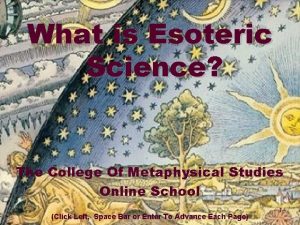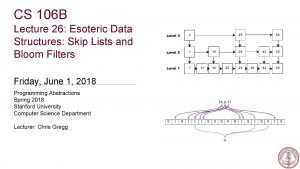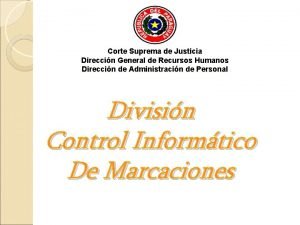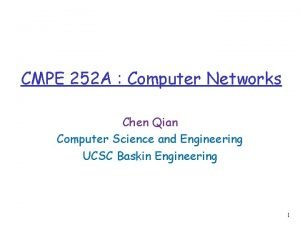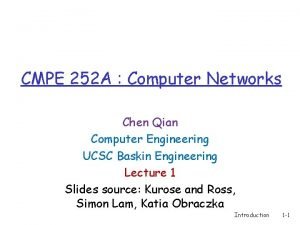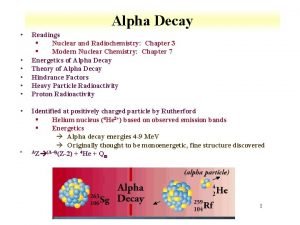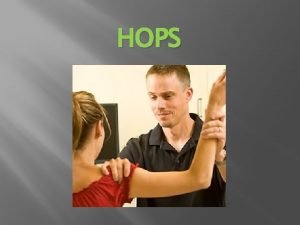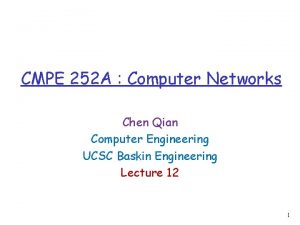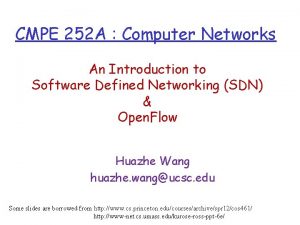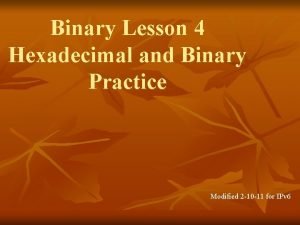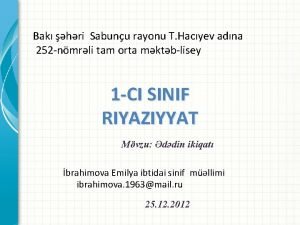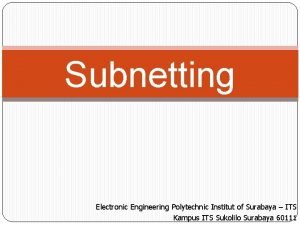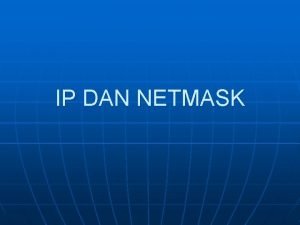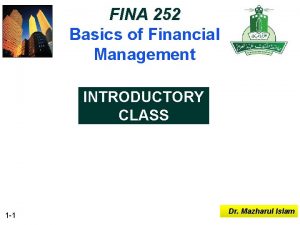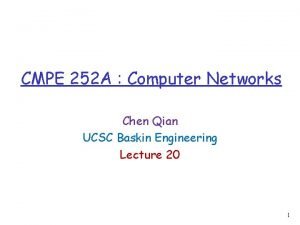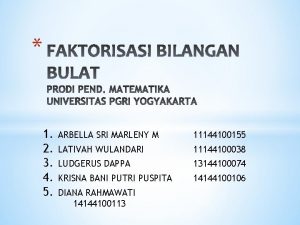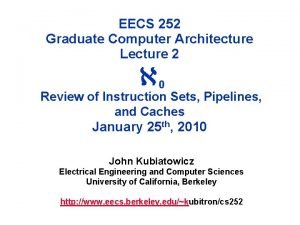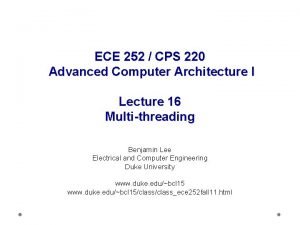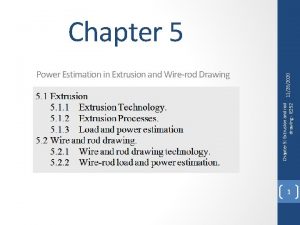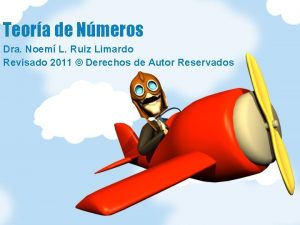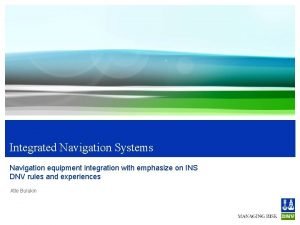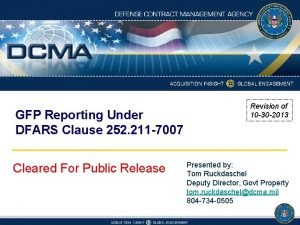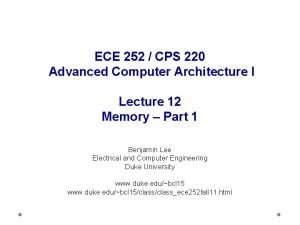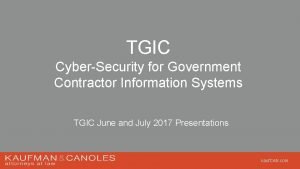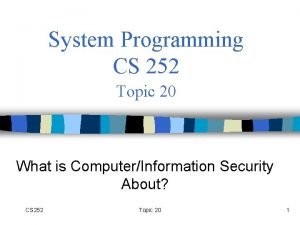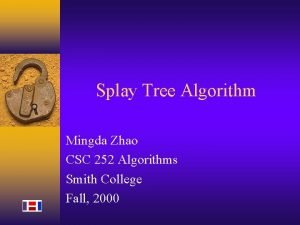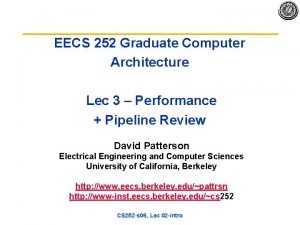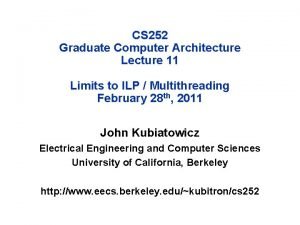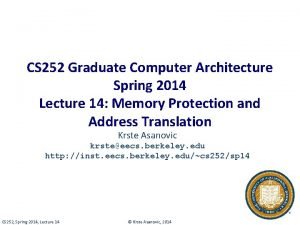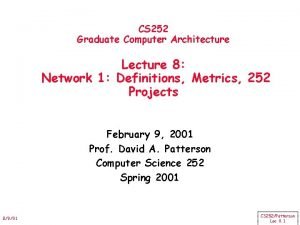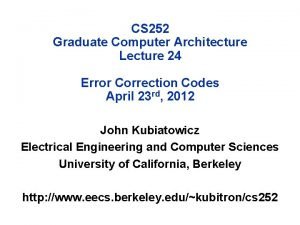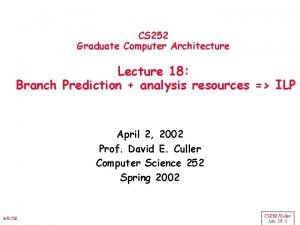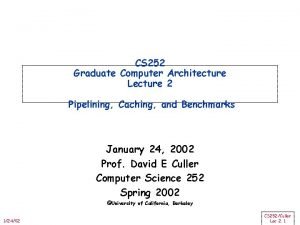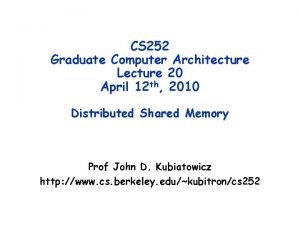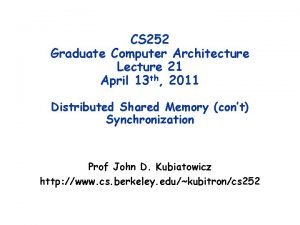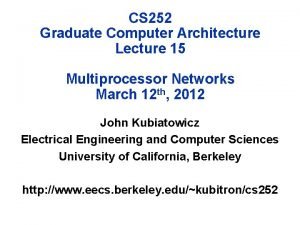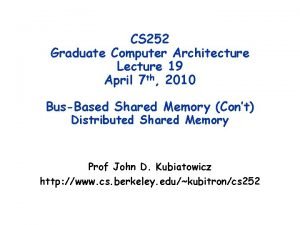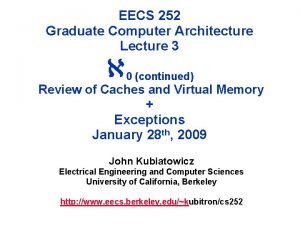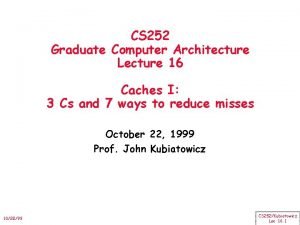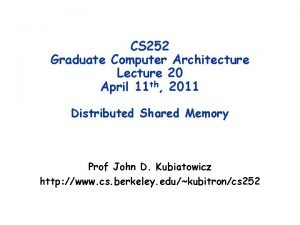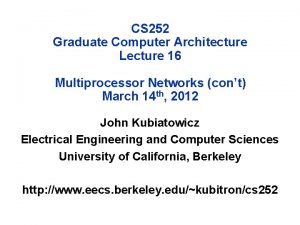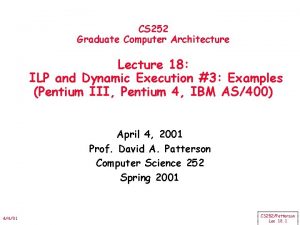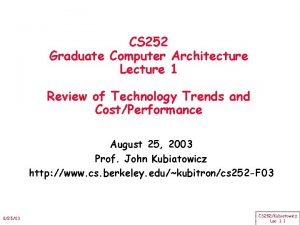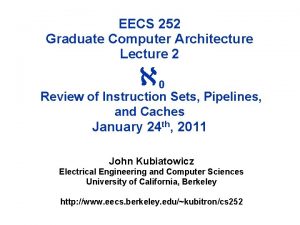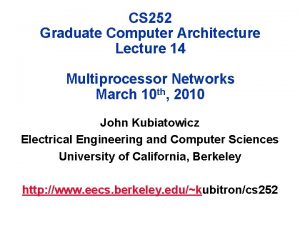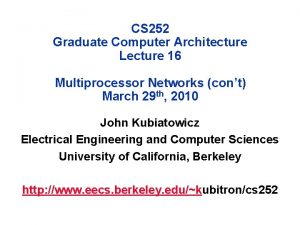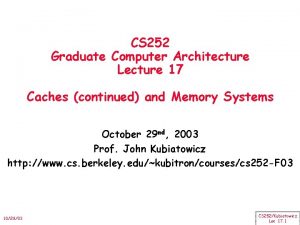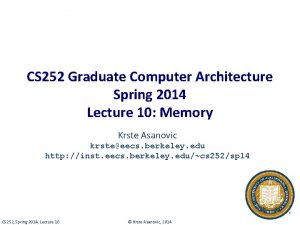CS 252 Graduate Computer Architecture Lecture 28 Esoteric


































- Slides: 34

CS 252 Graduate Computer Architecture Lecture 28 Esoteric Computer Architecture DNA Computing & Quantum Computing Prof John D. Kubiatowicz http: //www. cs. berkeley. edu/~kubitron/cs 252

DNA Computing • Can we use DNA to do massive computations? – Organisms do it – DNA has very high information density: » 4 different base pairs: • Adenine/Thymine • Guanine/Cytosine » Always paired on opposite strands Energetically favorable – Active operations: » Copy: Split strands of DNA apart in solution, gain 2 copies » Concatenate: eg: GTAATCCT will combine XXXXXCATT with AGGAYYYYY » Polymerase Chain Reaction (PCR): amplifies region of molecule between two marker molecules 5/11/2009 cs 252 -S 09, Lecture 28 © 1999 Access Excellence @ the National Health Museum 2

DNA Computing and Hamiltonian Path • Given a set of cities and costs between them (possibly directed paths): – Find shortest path to all cities – Simpler: find single path that visits all cities • DNA Computing example is latter version: – Every city represented by unique 20 base-pair strand – Every path between cities represented by complementary pairs: 10 pairs from source city, 10 pairs from destination – Shorter example: AAGT for city 1, TTCG for city 2 Path 1 ->2: CAAA Will build: AAGTTTCG. . CAAA. . – Dump “city molecules” and “path molecules” into testtube. Select and amplify paths of right length. Analyze for result. – Been done for 6 cities! (Adleman, ~1998!) 5/11/2009 cs 252 -S 09, Lecture 28 3

Even more promising uses of DNA • Self-assembly of components DNA Active Region Bonding – DNA serves as substrate – Attach active elements in middle of components. – Final step – metal deposited over DNA Active • Other interesting structures could be built. Region 5/11/2009 cs 252 -S 09, Lecture 28 4

Use Quantum Mechanics to Compute? • Weird but useful properties of quantum mechanics: – Quantization: Only certain values or orbits are good » Remember orbitals from chemistry? ? ? – Superposition: Schizophrenic physical elements don’t quite know whether they are one thing or another • All existing digital abstractions try to eliminate QM – Transistors/Gates designed with classical behavior – Binary abstraction: a “ 1” is a “ 1” and a “ 0” is a “ 0” • Quantum Computing: Use of Quantization and Superposition to compute. • Interesting results: – Shor’s algorithm: factors in polynomial time! – Grover’s algorithm: Finds items in unsorted database in time proportional to square-root of n. – Materials simulation: exponential classically, linear-time QM 5/11/2009 cs 252 -S 09, Lecture 28 5

Quantization: Use of “Spin” North Representation: |0> or |1> Spin ½ particle: (Proton/Electron) South • Particles like Protons have an intrinsic “Spin” when defined with respect to an external magnetic field • Quantum effect gives “ 1” and “ 0”: – Either spin is “UP” or “DOWN” nothing between 5/11/2009 cs 252 -S 09, Lecture 28 6

Kane Proposal II (First one didn’t quite work) Single Spin Control Gates Inter-bit Control Gates Phosphorus Impurity Atoms • Bits Represented by combination of proton/electron spin • Operations performed by manipulating control gates – Complex sequences of pulses perform NMR-like operations • Temperature < 1° Kelvin! 5/11/2009 cs 252 -S 09, Lecture 28 7

Now add Superposition! • The bit can be in a combination of “ 1” and “ 0”: – Written as: = C 0|0> + C 1|1> – The C’s are complex numbers! – Important Constraint: |C 0|2 + |C 1|2 =1 • If measure bit to see what looks like, – With probability |C 0|2 we will find |0> (say “UP”) – With probability |C 1|2 we will find |1> (say “DOWN”) • Is this a real effect? Options: – This is just statistical – given a large number of protons, a fraction of them (|C 0|2 ) are “UP” and the rest are down. – This is a real effect, and the proton is really both things until you try to look at it • Reality: second choice! – There are experiments to prove it! 5/11/2009 cs 252 -S 09, Lecture 28 8

A register can have many values! • Implications of superposition: – An n-bit register can have 2 n values simultaneously! – 3 -bit example: = C 000|000>+ C 001|001>+ C 010|010>+ C 011|011>+ C 100|100>+ C 101|101>+ C 110|110>+ C 111|111> • Probabilities of measuring all bits are set by coefficients: – So, prob of getting |000> is |C 000|2, etc. – Suppose we measure only one bit (first): » We get “ 0” with probability: P 0=|C 000|2+ |C 001|2+ |C 010|2+ |C 011|2 Result: = (C 000|000>+ C 001|001>+ C 010|010>+ C 011|011>) » We get “ 1” with probability: P 1=|C 100|2+ |C 101|2+ |C 110|2+ |C 111|2 Result: = (C 100|100>+ C 101|101>+ C 110|110>+ C 111|111>) • Problem: Don’t want environment to measure before ready! – Solution: Quantum Error Correction Codes! 5/11/2009 cs 252 -S 09, Lecture 28 9

Spooky action at a distance • Consider the following simple 2 -bit state: = C 00|00>+ C 11|11> – Called an “EPR” pair for “Einstein, Podolsky, Rosen” • Now, separate the two bits: Light-Years? • If we measure one of them, it instantaneously sets other one! – Einstein called this a “spooky action at a distance” – In particular, if we measure a |0> at one side, we get a |0> at the other (and vice versa) • Teleportation – Can “pre-transport” an EPR pair (say bits X and Y) – Later to transport bit A from one side to the other we: » Perform operation between A and X, yielding two classical bits » Send the two bits to the other side » Use the two bits to operate on Y » Poof! State of bit A appears in place of Y 5/11/2009 cs 252 -S 09, Lecture 28 10

Model: Operations on coefficients + measurements Input Complex State Unitary Transformations Measure Output Classical Answer • Basic Computing Paradigm: – Input is a register with superposition of many values » Possibly all 2 n inputs equally probable! – Unitary transformations compute on coefficients » Must maintain probability property (sum of squares = 1) » Looks like doing computation on all 2 n inputs simultaneously! – Output is one result attained by measurement • If do this poorly, just like probabilistic computation: – If 2 n inputs equally probable, may be 2 n outputs equally probable. – After measure, like picked random input to classical function! – All interesting results have some form of “fourier transform” computation being done in unitary transformation 5/11/2009 cs 252 -S 09, Lecture 28 11

• Security of Factoring • Easy Hard Easy 5/11/2009 The Security of RSA Public-key cryptosystems depends on the difficult of factoring a number N=pq (product of two primes) – – Classical computer: sub-exponential time factoring Quantum computer: polynomial time factoring Shor’s Factoring Algorithm (for a quantum computer) 1) Choose random x : 2 x N-1. 2) If gcd(x, N) 1, Bingo! 3) Find smallest integer r : xr 1 (mod N) 4) If r is odd, GOTO 1 5) If r is even, a x r/2 (mod N) (a-1) (a+1) = k. N 6) If a = N-1 GOTO 1 7) ELSE gcd(a ± 1, N) is a non trivial factor of N. cs 252 -S 09, Lecture 28 12

Finding r with xr 1 (mod N) Quantum Fourier Transform • Finally: Perform measurement – Find out r with high probability – Get |y>|aw’> where y is of form k/r and w’ is related 5/11/2009 cs 252 -S 09, Lecture 28 13

ION Trap Quantum Computer: Promising technology Cross. Sectional View Top • IONS of Be+ trapped in oscillating quadrature field – Internal electronic modes of IONS used for quantum bits – MEMs technology – Target? 50, 000 ions – ROOM Temperature! • Ions moved to interaction regions – Ions interactions with one another moderated by lasers 5/11/2009 Top View Proposal: NIST Group cs 252 -S 09, Lecture 28 14

Ion Trap Quantum Computer Q 1 Two-Qubit Gate • Major Components - Data = an ion - Gate = a location • Ballistic Movement - Apply pulse sequences to electrodes - Electrostatic forces move ion - Intersections similar, but more complicated pulse sequences Q 2 5/11/2009 cs 252 -S 09, Lecture 28 15

Ballistic Movement Network One-Qubit Gate Q 2 One-Qubit Gate Two-Qubit Gate R R R Q 3 R Two-Qubit Gate Q 4 Memory Cell Q 1 Interconnection Network Q 5 Memory Cell • Problem: Noise accumulation! 5/11/2009 cs 252 -S 09, Lecture 28 16

Qubit Error Noise Accumulation from Movement Distance Moved in Gates • Noise may increase error by factor of 100 5/11/2009 cs 252 -S 09, Lecture 28 17

Movement Option 2: Teleportation Source Location 2. Local Ops D 3. Transmit two classical bits Entanglement E 1 E 2 Target Location 4. Local Ops D? D 1. Generate EPR pair • Goal: Transfer the state, not the data ion • Problem: EPR pairs become noisy • Teleportation Benefits - Error Correction of data (arbitrary state): ~100 ms Purification of EPR pair (known state): ~120 µs - Pre-distribution of EPR pairs 5/11/2009 cs 252 -S 09, Lecture 28 18

EPR Pair Distribution Network One-Qubit Gate Q 2 One-Qubit Gate Two-Qubit Gate R R EPR Pair R Generators R Q 3 Two-Qubit Gate Q 4 Memory Cell Q 1 5/11/2009 Interconnection Network cs 252 -S 09, Lecture 28 Q 5 Memory Cell 19

Setting Up a Teleportation Link • Purification = Amplification of EPR pair link - Two EPR pairs One “purer” pair, one junk pair - Chance of failure • Need to send multiple pairs EPR Qubits Entanglement. EPR Qubits STRONGER P G Recycled Qubits 5/11/2009 P Recycled Qubits For Data Teleportation cs 252 -S 09, Lecture 28 20

Chained Teleportation T P G Teleportation T G T G T • Adjacent T nodes linked for teleportation P • Positive Features - T node linking not on critical path - Pre-purification (Link Amplification): part of link setup 5/11/2009 cs 252 -S 09, Lecture 28 21

Quantum Network Architecture T G G P Gate G T G T P Gate • Grid of T nodes , linked by G nodes • Packet-switched network - Dimension-order routing • Each qubit has associated message 5/11/2009 cs 252 -S 09, Lecture 28 22

Classical Control • Quantum Datapath Layer - T Nodes and G Nodes (P Nodes and Gates not shown) • Classical Control Layers - Messages Associated with Qubits - Teleportation and Purification Bits 5/11/2009 cs 252 -S 09, Lecture 28 23

Running a Quantum Circuit • Simple gates (transversal) • More complex gates (non-transversal) – Exist in any universal set • Quantum Error Correction (QEC) – 10 -8 to 10 -6 error rates from gates, movement and idleness – Data must be encoded and periodically error corrected • Ancilla (helper) qubits – Necessary for complex gates and for QEC – Computation with ancilla qubits > 90% of quantum program Q 0 Q 1 T time 5/11/2009 H QEC T QEC C X QEC QEC QEC T T QEC H QEC Serial Circuit Latency cs 252 -S 09, Lecture 28 24

Running a Quantum Circuit • Ancilla qubits are independent of data – Preparation may be pulled offline – Ancilla qubits should be ready just in time to avoid noise from idleness Q 0 H Q 1 T 5/11/2009 QEC C X QEC T QEC H QEC Parallel Circuit Latency cs 252 -S 09, Lecture 28 25

Running at The Speed of Data • Ideally, execution time determined solely by data Operations involving data qubits hardware time Ancilla encoding 5/11/2009 cs 252 -S 09, Lecture 28 26

Execution Time of a 32 -Bit QCLA (μs) Limited Ancilla Bandwidth Encoded Ancilla Bandwidth Available (Ancillae per ms) • 32 -bit Quantum Carry-Lookahead Adder – Varying rate at which encoded zero ancillae are provided for QEC – Conclusion: design architecture with “ancilla factories” 5/11/2009 cs 252 -S 09, Lecture 28 27

Ancilla Factory Design I • “In-place” ancilla preparation QEC 0 Prep Cat Prep Verify ? Bit Correct ? Phase Correct ? Ancilla Generation Circuit Encoded Ancilla Verification Qubits • Ancilla factory consists of many of these – – 5/11/2009 Encoded ancilla prepared in many places, then moved to output port Movement is costly! cs 252 -S 09, Lecture 28 In-place Prep 28

Idealized Qalypso Architecture • Dense data region – Data qubits only – Local communication • Shared Ancilla Factories – – Distributed to data as needed Fully multiplexed to all data Output ports ( ): close to data Input ports ( ): may be far from data, since recycled qubits have irrelevant state • Goals – Design ancilla factories – Answer Question: How much hardware is needed for ancilla generation to run at the speed of data? 5/11/2009 cs 252 -S 09, Lecture 28 29

Discussion of ISCA 2009 paper • “A Fault Tolerant, Area Efficient Architecture for Shor’s Factoring Algorithm” – Mark Whitney, Nemanja Isailovic, Yatish Patel, and John Kubiatowicz – ISCA 2009 • How to compare layouts? (what is good)? – Probabilistic circuits need metric that includes probability of failure – ADCR = Probabilistic version of area-delay product – Lower is better • What to optimize? – Many different “datapath organizations” – Far too much error correction 5/11/2009 cs 252 -S 09, Lecture 28 30

Datapath Organizations • QLA: “Quantum Logic Array” – Every compute region has space for 2 bits and ancilla generation for 2 bits (to correct after every operation • CQLA: “Compressed Quantum Logic Array” – Same compute regions as QLA, but ability to have less ancilla generation/bit for memory (idle bits less prone to error) • Qalypso – Matching ancilla generation to needs 5/11/2009 cs 252 -S 09, Lecture 28 31

Error Correction Optimization • Selectively error correction placement – Standard techniques: correct after every error – Instead – only correct bits that are particularly “dirty” • Error correction modeled after retiming optimization – Only place correction when approximate “EDist” parameter reaches threshold – Then, perform full mapping – Choose EDist by optimizing ADCR • Very successful at reducing area/latency • Even improves probability of success in some cases! – Why? Because error correction involves operations which can introduce error 5/11/2009 cs 252 -S 09, Lecture 28 32

Shor’s Factoring Circuit • Most of time spent in modular exponentiation – QFT is much smaller fraction of time – Easiest way to build modular exponentiation: with adders » Build multiplier instead? Not studied yet – would be very large • Paper result: can factor in 7659 mm 2 – Previous result was 0. 9 m 2 5/11/2009 cs 252 -S 09, Lecture 28 33

Conclusion • Computing can be done in a variety of ways – Normal silicon gates not required • DNA Computing – Limited use “demonstration of concept” – Form of massive parallelism – Interesting consequences: self assembly • Quantum Computing: – Computing using superposition and quantization – Ion Traps: a particularly promising technology • CAD Tools for Quantum Computing – Can actually optimize circuits – just like classical case – ADCR = probabilistic version of Area-Delay product 5/11/2009 cs 252 -S 09, Lecture 28 34
 Architecture lecture notes
Architecture lecture notes Microarchitecture vs isa
Microarchitecture vs isa Esoteric science
Esoteric science Esoteric data structures
Esoteric data structures 01:640:244 lecture notes - lecture 15: plat, idah, farad
01:640:244 lecture notes - lecture 15: plat, idah, farad Bus architecture in computer architecture
Bus architecture in computer architecture Difference between computer organisation and architecture
Difference between computer organisation and architecture What is basic computer organization
What is basic computer organization Acordada 709/11
Acordada 709/11 Chen qian ucsc
Chen qian ucsc Qian chen ucsc
Qian chen ucsc Cf-252 decay scheme
Cf-252 decay scheme Radical 108 simplified
Radical 108 simplified History observation palpation special tests
History observation palpation special tests Cmpe 252
Cmpe 252 Cmpe 252
Cmpe 252 Abcde em hexadecimal
Abcde em hexadecimal 252 nomreli mekteb
252 nomreli mekteb Its
Its 252 netmask
252 netmask 252 basics
252 basics Chen qian ucsc
Chen qian ucsc Fpb dari 198
Fpb dari 198 Cpi processor
Cpi processor Cps 220
Cps 220 Rod drawing
Rod drawing Factorizacion prima de 252
Factorizacion prima de 252 Msc.252(83)
Msc.252(83) Dfars 252
Dfars 252 Ece 252
Ece 252 Dfars 252 204 7012
Dfars 252 204 7012 Cs 252
Cs 252 Csc 252
Csc 252 Chapter 252 florida statutes
Chapter 252 florida statutes 252 lec
252 lec


